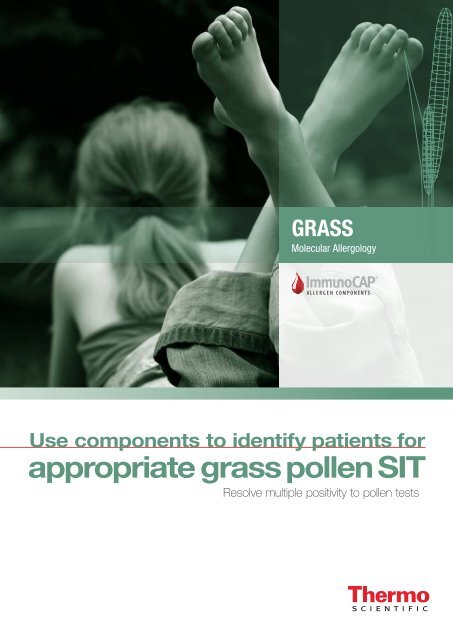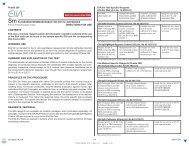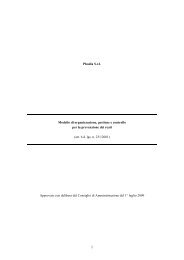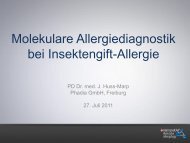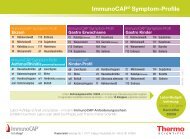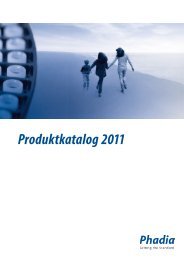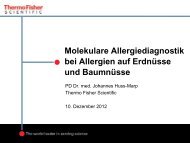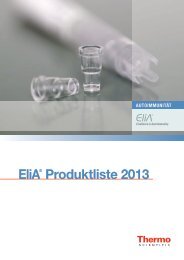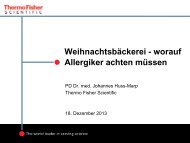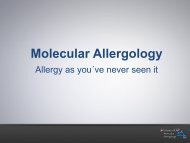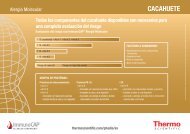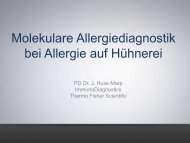Download: 1.1 MB - Phadia
Download: 1.1 MB - Phadia
Download: 1.1 MB - Phadia
You also want an ePaper? Increase the reach of your titles
YUMPU automatically turns print PDFs into web optimized ePapers that Google loves.
GRASS<br />
Molecular Allergology<br />
Use components to identify patients for<br />
appropriate grass pollen SIT<br />
Resolve multiple positivity to pollen tests
Take the diagnosis and management<br />
of grass pollen-allergic patients to a whole new level<br />
Use components to verify “true” grass pollen sensitization<br />
Grass pollen allergy is common and most grass pollen allergic patients are sensitized to several other<br />
pollens. 1,2,3 Components help to distinguish between positive results due to sensitization to specific grass<br />
pollens and the cross-reactivity to food, weed or tree pollens. 4,5<br />
• Grass pollen-specific components: Phl p 1, Phl p 2, Phl p 4, Phl p 5, Phl p 6, Phl p 11.<br />
• Markers for cross-reactivity: Phl p 7 (polcalcin), Phl p 12 (profilin).<br />
Identify patients for appropriate SIT treatment<br />
An accurate diagnosis on the molecular level increases the likelihood of successful SIT; patients<br />
with primary sensitization to specific components have a better outcome of treatment as compared<br />
to patients sensitized only to cross-reactive components. 6,7,8,9<br />
A recent study showed that more than 50 % of the patients had their pollen SIT treatment changed<br />
when components where used in the diagnostic work-up. 10<br />
Improved patient management and quality of life<br />
An accurate grass pollen diagnosis and appropriate immunotherapy can:<br />
• Reduce allergic symptoms<br />
• Improve the quality of life<br />
• Optimize SIT outcome
Suggested profiles for SIT decision<br />
Phleum pratense<br />
ImmunoCAP ®<br />
Allergen<br />
Components<br />
Phl p 1, Phl p 5b Phl p 2, Phl p 4, Phl p 6, Phl p 11 Phl p 7, Phl p 12<br />
· Specific components<br />
for grass<br />
· Indication for grass<br />
pollen SIT<br />
· Specific components<br />
for grass<br />
· Data on SIT outcome are<br />
not available in literature<br />
· Cross-reactive allergen<br />
components<br />
· Often minor allergens<br />
which may not be available<br />
in sufficient amount in<br />
the SIT extract<br />
· IgE to Phl p 7 and 12 alone<br />
indicate low suitability for<br />
grass pollen SIT. Keep on<br />
looking for the real cause.<br />
Did you know that?<br />
• Grass pollen allergy is common worldwide, and in some regions up to 40 % of atopics<br />
show sensitization to grass pollen. 1,4,11<br />
• Group 1 and group 5 allergens (Phl p 1 and Phl p 5) are the dominating grass pollen<br />
allergens. More than 90 % of patients with sensitization to grass pollen have IgE abs<br />
to Phl p 1 and/or Phl p 5. 4,5,8<br />
• Sensitization to the cross-reactive allergens profilin and polcalcin is usually not frequent<br />
(< 20 %). When no specific grass sensitization is detected other pollen or food specific<br />
components should be investigated. 3,4,8<br />
• Up to 30 % of patients suffering from pollinosis simultaneously present allergy to<br />
fruits and vegetables, such as peanut, soy and tomato, either due to cross-reactivity<br />
or true co-sensitization. 2<br />
• The SIT extract chosen for treatment should ideally contain appropriate concentrations<br />
of the components indicated as trigger of the symptoms. 6,9,11<br />
• Effective SIT is usually associated with increased IgG4 and reduced IgE antibody levels.<br />
Grass components can be used to monitor the levels of IgE and IgG4 during SIT treatment<br />
to ensure compliance. 9,12,13<br />
• SIT treatments are expensive and prescribed for several years. A correct diagnosis<br />
is therefore important. 6,14
Make a precise assessment<br />
ImmunoCAP Allergen Components help you differentiate between ”true” allergies<br />
and cross-reactivity<br />
Make a substantiated decision<br />
A better differentiation helps you give relevant advice and define the optimal treatment<br />
Make a difference<br />
More informed management helps you improve the patient’s well-being and quality of life<br />
References: 1. Barber D. et al. Understanding patient sensitization profiles in complex pollen areas: a molecular epidemiological study. Allergy. 2008 Nov; 63(11): 1550–8.<br />
2. Cuesta-Herranz J. et al. Differences among pollen-allergic patients with and without plant food allergy. Int Arch Allergy Immunol. 2010; 153(2): 182–92. 3. Hauser M. et al.<br />
Panallergens and their impact on the allergic patient. Allergy Asthma Clin Immunol. 2010; 6(1): 1. 4. Andersson K. et al. Characteristics and immunobiology of grass pollen allergens.<br />
International Archives of Allergy & Immunology. 2003; 130(2): 87–107. 5. Sekerkova A. et al. Detection of Phl p 1, Phl p 5, Phl p 7 and Phl p 12 specific IgE antibodies in<br />
the sera of children and adult patients allergic to Phleum pollen. Allergol Int. 2012 Jun; 61(2): 339–46. 6. Walker S.M. et al. Immunotherapy for allergic rhinitis. Clin Exp Allergy.<br />
2011 Sep; 41(9): 1177–200. 7. Schmid-Grendelmeier P. Recombinant allergens. For routine use or still only science? Hautarzt. 2010 Nov; 61(11): 946–53. 8. Tripodi S. et al.<br />
Molecular profiles of IgE to Phleum pratense in children with grass pollen allergy: Implications for specific immunotherapy. J Allergy Clin Immunol. 2012 Mar; 129(3): 834–9 e8.<br />
9. Valenta R. et al. Component-resolved diagnosis to optimize allergen-specific immunotherapy in the Mediterranean area. J Investig Allergol Clin Immunol. 2007; 17 Suppl 1: 36–40.<br />
10. Sastre J. et al. How molecular diagnosis can change allergen-specific immunotherapy prescription in a complex pollen area. Allergy. 2012 May; 67(5): 709–11. 11. Hatzler L.<br />
et al. Molecular spreading and predictive value of preclinical IgE response to Phleum pratense in children with hay fever. J Allergy Clin Immunol. 2012 Oct; 130(4): 894–901 e5.<br />
12. Jutel M. et al. Allergen-specific immunotherapy with recombinant grass pollen allergens. Journal of Allergy & Clinical Immunology. 2005; 116(3): 608–13. 13. Rossi R.E. et<br />
al. Evaluation of 70 polysensitised allergic patients with skin prick test and an allergen microarray. IT J Allergy Clin Immunol. 2007; 17: 158–64. 14. Canonica G.W. et al. Costeffectiveness<br />
of GRAZAX for prevention of grass pollen induced rhinoconjunctivitis in Southern Europe. Respir Med. 2007 Sep; 101(9): 1885–94.<br />
thermoscientific.com/phadia<br />
© 2012 Thermo Fisher Scientific Inc. All rights reserved. All trademarks are the property of Thermo Fisher Scientific Inc. and its subsidiaries.<br />
Manufacturer; <strong>Phadia</strong> AB, Uppsala Sweden.<br />
Head office Sweden +46 18 16 50 00<br />
Austria +43 1 270 20 20<br />
Belgium +32 2 749 55 15<br />
Brazil + 55 11 3345 5050<br />
China +86 25 8960 5700<br />
Czech Republic +420 220 518 743<br />
Denmark +45 70 23 33 06<br />
Finland +358 9 3291 0110<br />
France +33 1 61 37 34 30<br />
52-5109-08 956-2200 1211 heart.se<br />
Germany +49 761 47 8050<br />
Hong Kong +852 2885 4613<br />
India +91 11 4610 7555/56<br />
Italy +39 02 64 163 411<br />
Japan +81 3 5365 8332<br />
Korea +82 2 2027 5400<br />
Norway +47 21 67 32 80<br />
Portugal +351 21 423 5350<br />
South Africa +27 11 792 6790<br />
Spain +34 935 765 800<br />
Sweden +46 18 16 60 60<br />
Switzerland +41 43 343 4050<br />
Taiwan +886 2 2516 0925<br />
The Netherlands +31 30 602 37 00<br />
United Kingdom/Ireland +44 1 908 769 110<br />
USA +1 800 346 4364<br />
Other countries +46 18 16 50 00


